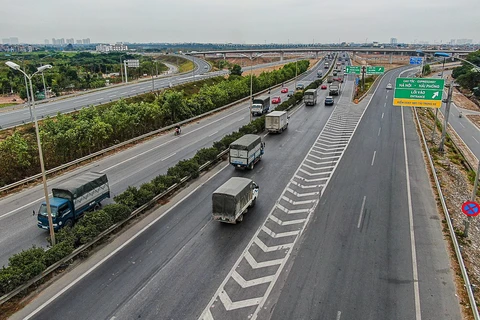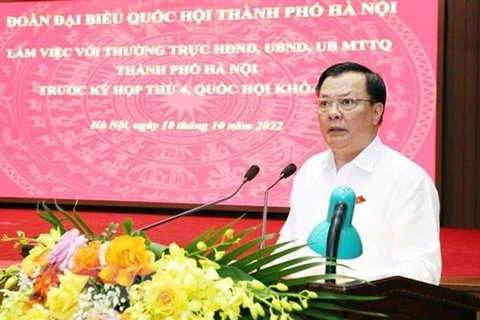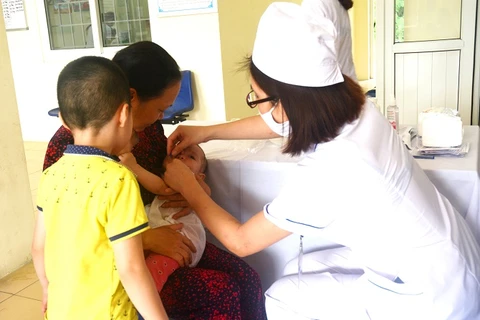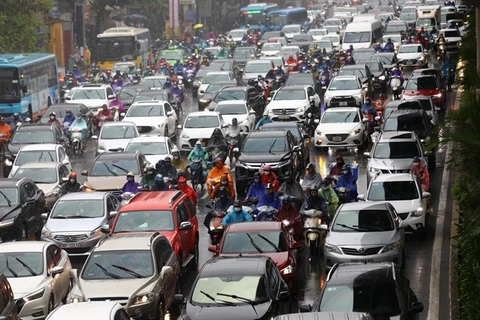Hanoi (VNA) – The Hanoi Department of Transport has given the green light to the pilot of an electric two-wheeler sharing model to facilitate the transit of bus rapid transit (BRT) passengers.
The pilot project is one of the measures to strengthen the management of road vehicles in a bid to reduce traffic congestion and environmental pollution in the capital city. Its cost is sourced from funding of the European Committee (EC) and support of participating agencies.
Developed by the University of Transport Technology, the model will be operated starting the end of November, offering free electric bikes and bicycles for shared use during the pilot period.
The vehicles help passengers of the Kim Ma-Yen Nghia BRT route to travel between the Van Khe bus stop and Aeon Mall Ha Dong.
People wishing to use the system will be supported by BRT staff to install the required application on their mobile phones and register their information at the bus stop and the mall. After being verified, the passengers can hire electric vehicles for their transit routes between the two destinations, which both offer parking spaces for their private means of transport if any.
The process of moving between the two points is tracked and stored in a system via the previously installed application. The system also provides the necessary functions for the sharing model, including monitoring the vehicles’ battery status and raising an alarm when problems arise.
The Hanoi BRT project started in 2013 at a cost of 53.6 million USD, financed through World Bank loans, and was officially put into operation on the Kim Ma – Yen Nghia route starting December 31, 2016. The route covers 14.7km from Kim Ma station in Ba Dinh District to Yen Nghia station in Ha Dong District. With prioritised traffic lights and lanes, the buses run through Giang Vo, Lang Ha, Le Van Luong, Le Trong Tan, Tran Phu and Ba La streets.
Buses in Hanoi served 212.7 million passengers in the first nine months of 2022, rising by over 25% from a year earlier, statistics show. The passenger number has bounced back since the second quarter and gradually increased month on month.
This result is partly attributed to the opening of 11 new bus routes, including five connected with the Cat Linh - Ha Dong urban railway and six using electric vehicles, raising the number of e-bus routes to nine.
Hanoi is aiming for broader coverage by its bus network, so that 80-90% of residents in downtown areas can catch a bus by 2030.
This is part of Plan No 201/KH-UBND, issued by the municipal People’s Committee, on developing local public transport between 2021 and 2030.
Infrastructure for public transport will be developed under the plan, so as to ensure that by 2030, 80-90% of residents in downtown areas have a bus service within 500 metres of their home.
Hanoi will work to expand its public transport network to populous places such as residential areas and industrial parks, outlying districts, and socio-economic development centres, while ensuring the network’s connectivity with transport hubs and other transport modes.
Traffic will be managed in a way that prioritises public transport, while science and technology application will be increased in transport activities and communications will be enhanced to encourage people to use public transport.
Bus services currently meet 16.08% of travel demand in Hanoi, which falls short of expectations. The capital does, however, boast the largest bus network in the country, with 122 routes reaching all 30 district-level localities.
Hanoi now aims to develop a public transport system that can meet 30-35% of local residents’ travel demand by 2025.
Under an action plan recently issued by the municipal People’s Committee on strengthening traffic safety and preventing congestion for the 2022-2025 period, the number of traffic accidents in the locality will be reduced by 5-10% so that by 2030, the number of injuries and fatalities caused by road accidents will be dropped by a half. It also sets a target of handling seven to ten traffic points that often get congested every year.
To realise those goals, the city administration will mobilise all resources and concertedly carry out measures along with the application of scientific and technological advances in ensuring traffic safety and order and preventing gridlock towards building a comfortable, effective and environmental-friendly traffic system.
It will focus investment on key traffic routes and urban railways in line with approved planning.
The capital city will rearrange parking lots in both inner-city and outlying districts, build a transport system that facilitates access for people with disabilities and the elderly, as well as study a pilot programme on a bicycle-only lane./.
The pilot project is one of the measures to strengthen the management of road vehicles in a bid to reduce traffic congestion and environmental pollution in the capital city. Its cost is sourced from funding of the European Committee (EC) and support of participating agencies.
Developed by the University of Transport Technology, the model will be operated starting the end of November, offering free electric bikes and bicycles for shared use during the pilot period.
The vehicles help passengers of the Kim Ma-Yen Nghia BRT route to travel between the Van Khe bus stop and Aeon Mall Ha Dong.
People wishing to use the system will be supported by BRT staff to install the required application on their mobile phones and register their information at the bus stop and the mall. After being verified, the passengers can hire electric vehicles for their transit routes between the two destinations, which both offer parking spaces for their private means of transport if any.
The process of moving between the two points is tracked and stored in a system via the previously installed application. The system also provides the necessary functions for the sharing model, including monitoring the vehicles’ battery status and raising an alarm when problems arise.
The Hanoi BRT project started in 2013 at a cost of 53.6 million USD, financed through World Bank loans, and was officially put into operation on the Kim Ma – Yen Nghia route starting December 31, 2016. The route covers 14.7km from Kim Ma station in Ba Dinh District to Yen Nghia station in Ha Dong District. With prioritised traffic lights and lanes, the buses run through Giang Vo, Lang Ha, Le Van Luong, Le Trong Tan, Tran Phu and Ba La streets.
Buses in Hanoi served 212.7 million passengers in the first nine months of 2022, rising by over 25% from a year earlier, statistics show. The passenger number has bounced back since the second quarter and gradually increased month on month.
This result is partly attributed to the opening of 11 new bus routes, including five connected with the Cat Linh - Ha Dong urban railway and six using electric vehicles, raising the number of e-bus routes to nine.
Hanoi is aiming for broader coverage by its bus network, so that 80-90% of residents in downtown areas can catch a bus by 2030.
This is part of Plan No 201/KH-UBND, issued by the municipal People’s Committee, on developing local public transport between 2021 and 2030.
Infrastructure for public transport will be developed under the plan, so as to ensure that by 2030, 80-90% of residents in downtown areas have a bus service within 500 metres of their home.
Hanoi will work to expand its public transport network to populous places such as residential areas and industrial parks, outlying districts, and socio-economic development centres, while ensuring the network’s connectivity with transport hubs and other transport modes.
Traffic will be managed in a way that prioritises public transport, while science and technology application will be increased in transport activities and communications will be enhanced to encourage people to use public transport.
Bus services currently meet 16.08% of travel demand in Hanoi, which falls short of expectations. The capital does, however, boast the largest bus network in the country, with 122 routes reaching all 30 district-level localities.
Hanoi now aims to develop a public transport system that can meet 30-35% of local residents’ travel demand by 2025.
Under an action plan recently issued by the municipal People’s Committee on strengthening traffic safety and preventing congestion for the 2022-2025 period, the number of traffic accidents in the locality will be reduced by 5-10% so that by 2030, the number of injuries and fatalities caused by road accidents will be dropped by a half. It also sets a target of handling seven to ten traffic points that often get congested every year.
To realise those goals, the city administration will mobilise all resources and concertedly carry out measures along with the application of scientific and technological advances in ensuring traffic safety and order and preventing gridlock towards building a comfortable, effective and environmental-friendly traffic system.
It will focus investment on key traffic routes and urban railways in line with approved planning.
The capital city will rearrange parking lots in both inner-city and outlying districts, build a transport system that facilitates access for people with disabilities and the elderly, as well as study a pilot programme on a bicycle-only lane./.
VNA
























